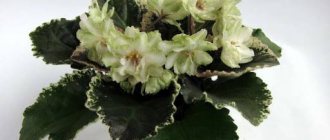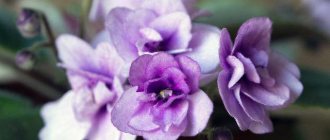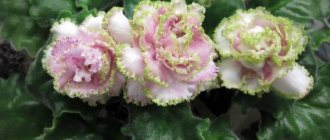Description of the White Queen species
Features and differences from other types of violets
I think that the White Queen violet has a snow-white color is already obvious. Violet is also distinguished by larger flowers, lush flowering and slow rosette growth.
Leaves
The diameter of the rosette is 25-30 cm. During flowering, the rosette is almost completely covered by lush flowers. The leaves have a pleasant green color with a slight shine. The edges of the leaves have a wavy and pointed shape. With age, the cuttings become more rigid and therefore break easily.
Flowers
The flowers are large and lush, so large that the peduncle The peduncle is the upper part of the stem on which the inflorescence grows. At the initial stages of development in orchids, it is difficult to distinguish the peduncle from the root. Here are some differences: • bends under their weight. The diameter of each flower ranges from 7 to 7.5 cm. The White Queen species blooms in approximately 2 months. Flowering lasts up to two weeks. Sometimes the violet may change color. Most often this happens during hot periods. The petals may turn pink and your White Queen may turn Pink.
Types and varieties of Saintpaulia
All violets were divided into several groups to facilitate orientation among the many species. There are three groups:
- collectible;
- variegated;
- industrial.
Variegated varieties are characterized by the brightest color of the leaves, which can be painted in different colors. They often have a border around the edges. The first variegated varieties bloomed with small and simple inflorescences, but later breeders developed species distinguished by large double flowers of different colors.
Industrial - intended for mass cultivation on special plantations. They are available for purchase in large quantities. Their appearance is the simplest. These plants are mainly used to decorate banquet halls and are placed in offices and government institutions. These varieties bloom actively for a long time.
Collectibles - characterized by large inflorescences measuring from five to seven centimeters. They differ from others in that almost all of them have large, terry, wavy petals, painted in a wide range of colors: from snow-white to rich blue shades. The leaves also vary in color and have wavy edges.
Autumn treatment of the garden with urea
Autumn treatment of grapes against diseases and pests
Autumn treatment of fruit trees and shrubs
Caring for violets at home
Lighting
To get large blooms, you need to keep the White Queen violet on the window. This variety does not respond well to artificial lighting, but direct sunlight will also be destructive. Western or eastern windows are well suited for growing the White Queen. In very sunny weather, it is advisable to shade the violet. If the lighting rules are violated, the violet will not be able to produce as many lush blooms.
Temperature
The optimal temperature for growing White Queen violets is 20-22 degrees. Maintaining this temperature regime at home is not difficult. If the temperature is very high, the violet may lose its white color and begin to take on a pink tint.
Humidity
Air humidity is standard for most violets, namely 50-60%. It is not advisable to use a sprayer to increase humidity. Spots may appear on the leaves, and rot will begin to multiply. A good option would be a container of water. Just install it next to the plant. The water will gradually evaporate and fill the air with moisture.
Watering the White Queen violet
The most important thing when watering is to be moderate. The White Queen violet does not tolerate waterlogging very well. The roots begin to rot and the flower may die. At the same time, everyone needs to water regularly. You can also use regular tap water. But it is desirable that it be settled. Of course, one of the best options would be rain or melt water. There are three methods of watering, top, bottom and wick.
The top method is the simplest and least troublesome. Carefully pour water into the edge of the pot. Do not allow water to get on the leaves or in the center of the rosette. If this does happen, remove the water with a napkin.
When watering from below, you need to place the flower pot in a container of water. Water should cover two thirds of the pot. The procedure should be completed when the surface of the soil begins to shine. On average, this should take 20 minutes. Wick watering is very convenient if everything is set up correctly. A cord with a diameter of 3-5 mm should be placed in the soil of the flower. The end must be passed through the pot and the other end placed in a container of water. The container with water should be lower than the violet.
Fertilizer
It’s worth saying right away that fertilizer is not mandatory. But in case of lack of nutrients, it must be used. Quite often, the White Queen violet needs regular soil replacement. Moreover, if the soil is of high quality and fertile, then there will be enough nutrients. In this case, the violet needs to be replanted once every six months. If you feed your plant, then less often.
The plant needs to be fed once every two to three weeks during the growth period. Both mineral and complex fertilizers are suitable. Organic fertilizers work well during the development stage while the violet is young. In the future it is better to refuse them. Be sure to water the violet before fertilizing. If the violet is sick, or the transplant was done recently, there is no need to feed the White Queen.
Pot and soil
There is a certain rule for pots that are bought for violets. The diameter of the pot should be three times smaller than the diameter of the rosette. A pot that is too large will take a lot of energy from the violet, and it will not be able to please you with flowering.
Substrate In plant growing, this term refers to mixtures composed of various natural components and their substitutes. These components can be: peat, pine bark, sphagnum moss, fern roots, for the White Queen species, as for other species, it must be loose. Soil made from turf soil, peat, sand and vermiculite in a ratio of 5:3:1:1, respectively, is suitable. You can also use regular purchased soil. Many gardeners advise mixing it with vermiculite in a ratio of 10:1.
Transplanting violets
The White Queen violet needs to be replanted after flowering has ended. The violet needs to be removed from the old pot, carefully clean the roots from the old soil. Inspect the roots; if there are dried or rotten ones, you need to get rid of them immediately. Place drainage 3-5 centimeters high in the new pot. Add soil, place the violet there and gently sprinkle with soil. Lightly compact the soil.
Saintpaulia Water
Large blue flowers with lightened fragments along the edges of the petals, which have an abundant green ruffle. Quilted green leaf with wavy edge. The buds open gradually and last in cool weather for more than a month. The peduncles are strong, low, and hold from 4 to 6 ball flowers. Medium size socket. All the beauty of the variety is revealed in the second flowering.
Reproduction of violet White Queen
The White Queen reproduces well both by leaf and by shoots. For propagation by leaves, you need to carefully select them. The leaf should not be young or very old. As a rule, leaves from the second row work well. The cut leaf is placed in a glass of water and waits for roots to form. When the roots grow to half a centimeter, the cuttings are transplanted into the ground.
Stepchildren are simply transplanted into a separate pot and greenhouse conditions are created. You can cover the plant with film or a jar, ventilating it from time to time. In 8-9 months you will have a new, full-fledged White Queen violet.
Saintpaulia Aphrodite
The variety is named after the ancient Greek goddess of love. The variety has white double flowers with pink-lilac spots and the same border. As the temperature rises, the color becomes bright lilac. It blooms profusely, usually with up to 7 flowers in a peduncle. It does not require complex care; flowering requires a lighting level of 12-13 hours.
Saintpaulia Blue Fog
Thanks to regular experiments with Saintpaulia, the young Russian breeder Konstantin Morev created several new attractive varieties. Among them is the violet “Blue Mist”, which appeared in 2001. Its distinctive feature is light blue or light blue double flowers with a white border. The rosette is dark green, spreading. Double flowers differ from ordinary ones in the multi-row structure of the buds and the wavy (corrugated) edges of the petals. The variety has a standard size. The rosette is flat, symmetrical, and in rich soil it grows up to 40 cm or more. The foliage is wavy and round in shape. The edges are jagged, the color is green. Blooming flowers resemble a ball in shape, their diameter is 7-8 cm. Flowering occurs in waves, with an interval of 1-3 months between them.
Flower growers note several advantages of this variety:
- a beautiful cap on persistent peduncles;
- abundant and long flowering;
- easy care;
- rapid growth, flowering for up to a year;
- easy to reproduce.
From all this beauty, we tried to choose the most unusual and beautiful varieties.
Saintpaulia Duchess
So what can we say about this variety? First of all, she is really very beautiful, a real duchess! This beauty can delight its owner with flowers of unusual texture and color. This variety has very beautiful flowers, corrugated, and also very large in size. To the touch, like most violets, they are terry. The petals of this violet are white in color, but plum-colored “overprints” also appear on them. The brightness of the shade may also vary slightly - when the flower is fully bloomed, you will get a rich plum color. The leaves of the PC-Duchess violet are not too large, medium in size, and against their background the flowers themselves look quite impressive. The foliage is painted in a pleasant dark green color, due to which the flowers of this plant look much more expressive.
In addition, it is worth considering that violets of this variety do not tolerate heat very well. They are oriented towards a more or less cool climate, so keeping such flowers in fairly warm conditions can negatively affect their development. Therefore, if you purchase this variety, the most successful option would be to place this beauty on a north window.











